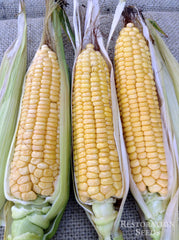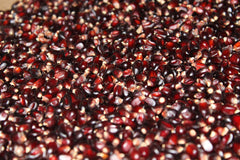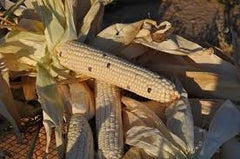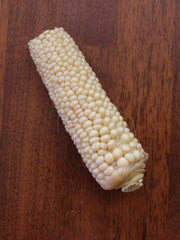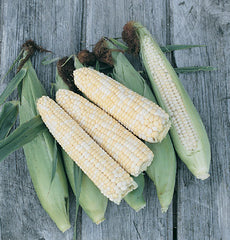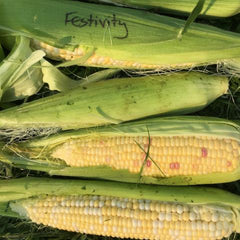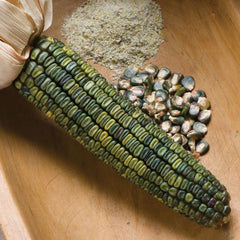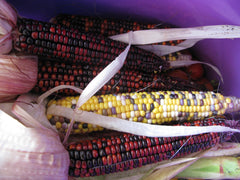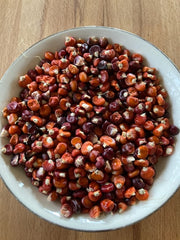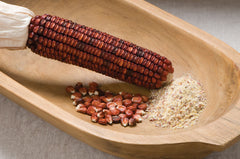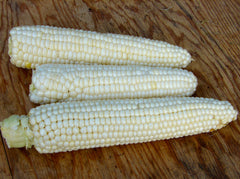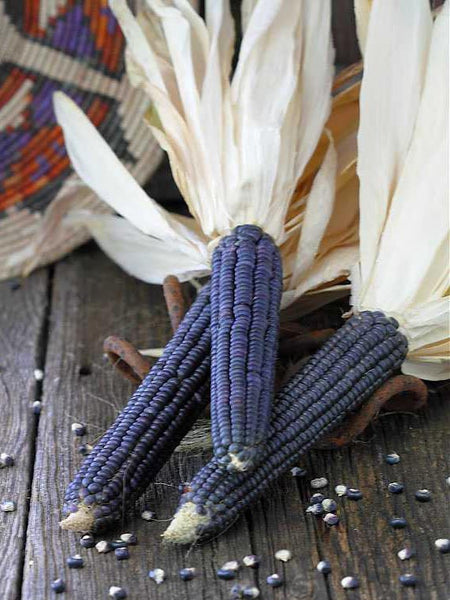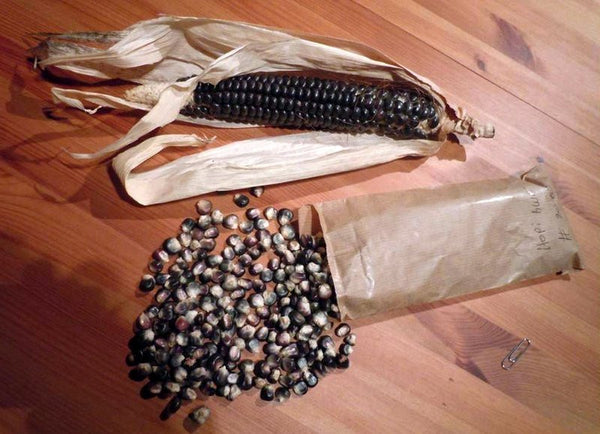Hopi Blue
Zea maysDays from maturity calculated from the date of seeding. Average 120–156 seeds per ounce, about 10–15 pounds per acre. Federal germination standard: 75%. Usual seed life: 5-10 years. Isolation distance for seed saving: 2 miles.
Planting Depth 1-2”
Soil Temp. Germ. 55–65˚F
Days to Germ. 4-12
Plant Spacing 8”
Row Spacing 30”
Days To Maturity 90–110
Full Sun, Moist Well Drained
Hopi Blue Seed Count
.25 Pound ≈ 353 seeds
1 Pound ≈ 1,413 seeds
- 100 Seeds$4.10
- 1/4 Pound$18.00
- 1 Pound$38.00
Blue corn was originally developed by the Hopi for growing in sandy dryland conditions. Early in the century, USDA botanist G.N. Collins discovered that Hopi Blue adaptations to deep-seeded clumped plantings in sand dune environments. One adaptation is the robust seedlings rapid elongation between the root and t...
Blue corn was originally developed by the Hopi for growing in sandy dryland conditions. Early in the century, USDA botanist G.N. Collins discovered that Hopi Blue adaptations to deep-seeded clumped plantings in sand dune environments. One adaptation is the robust seedlings rapid elongation between the root and the first foliage leaf, allowing it to emerge from beneath 12” (30.5 cm) or more of sand! of. Hope farmers did plant their corn seed 8–12” deep, for the sand stays moist at this depth. The seedlings that emerged in May could endure on the residual moisture from winter and spring storms until winter rains began.
Hopi Blue is grown today for tortillas, chips, cornbread. It can be eaten sweet when harvested young. In addition to its sharply different color, blue corn has several nutritional advantages over standard yellow or white corn varieties. It contains 30 percent more protein and has a lower glycemic index than white corn. When used to make tortillas, blue corn produces a sweeter, nuttier taste than yellow or white corn, and is a more complete protein source. Traditionally, is used for making piki bread, one of the most important foods in Hopi culture. It is ground into a cornmeal. Ground blue corn and ash (for color) are added to boiling water to make the cornmeal, which is spread by hand on a hot stone and cooked.
Different varieties of blue corn range in color from powdery gray to nearly black. There are three varieties of the blue corn: "standard" blue (sakwaqa'o), hard blue (huruskwapu), and gray-blue (maasiqa'o). Because of its hard kernels, huruskwapu is most resistant to storage pests and traditionally was the preferred variety for storing. When the grinding was all done by hand, women preferred using maasiqa'o because it is soft and easier to grind but the color was not as vibrant as that of the sakwaqa'o or huruskwapu.
Besides being the backbone of their diet, blue corn represents an essential part of the Hopi culture. The Hopi associate the ears of six colors of corn with the solstitial directions, plus the above and the below. Blue corn is associated with the direction of winter solstice sunset. They believe that blue corn represents a long life; Hopi men ate blue corn before undertaking long journeys because they believe it gives them great strength. To this day, the Hopi believe in the power of blue corn, as demonstrated by their story of creation.
Ours is the fifth population strain identified from the Talavaya Center, Espanola, New Mexico in 1990 by the University of Purdue. Also known as Hopi maize was identified as "Hopi blue corn" to avoid confusion with the four other blue corn populations from New Mexico and Colorado. Hopi blue corn reached a plant height of 6–8” (1.8 to 2.4 m) with only 2–3 tillers (suckers) per plant, about twice as tall as other blue corn varieties with 8 to 10 suckers. Do not over water during early growth phases to avoid lodging of leggier plants. Hope blue averages two 9” blue purple ears per plant.
As blue corn advances in maturity, the kernels will be white until the drydown period. At this time, the blue color appears and darkens as drydown progresses. Harvest should begin when the grain moisture reaches 18% and should progress rapidly.
Tags: Type: Flour, Color: Blue, Specialty: Drought Tolerant, Heritage: Heirloom, Certification: Organic.Corn has been cultivated for at least 5,000 years probably originating in the lowlands of western Mexico. Maize geneticists believe that 90 percent of breeding work in corn had already been done by the time Columbus arrived to find large fields of corn being grown on the island of Hispaniola in 1492. Modern sweet corn most likely descends from flint corns of the northeastern U.S. The sweet corn gene (sugary1, su1) was selected by Native American in at least four additional locations: highlands of Peru, central plateau of Mexico, northwestern Mexico southwestern U.S. and the northern Great Plains. Corn types are sweet corn, starch, parch, flint, dent, popcorn and ornamental. Corn types are sweet corn, starch, parch, flint, dent, popcorn and ornamental.
Native Americans planted corn when the gooseberry bushes were almost in full leaf. They cultivated about 18” diameter, pulled up last year’s dead roots in the spring and formed a hill. Six to eight seeds were planted in the center 9”. Later more earth was hilled up to cover the roots to protect them from the summer sun. Hills were 4’, far enough part so the leaves of mature plants would not touch. Beans and squash were planted after the corn. Beans were planted diagonally between the corn hills across the whole field. Squash was planted in rows outside to separate from the neighbor’s field. Four squash seeds were planted in pairs into opposite sides of a 15” diameter hill.
Companions: squash, pole beans, sunflowers, pumpkins, peas, cucumbers, potatoes, marigold
Inhibitors: tomatoes
Meet Your Farmer
We promote fair trade, organic practices and environmental responsibility throughout the Restoration Seeds supply chain. Below are the family farmers and seed suppliers who bring our open pollinated seeds to you.

